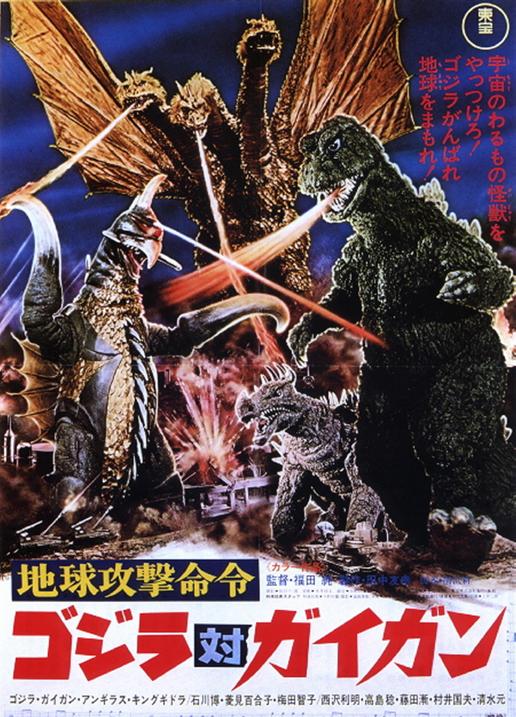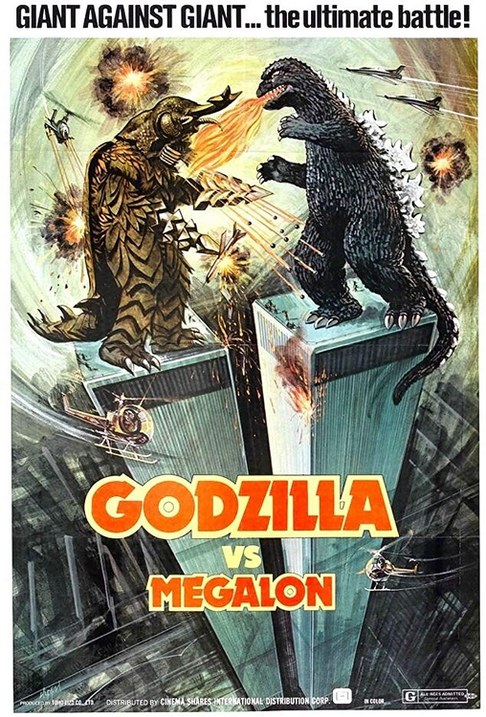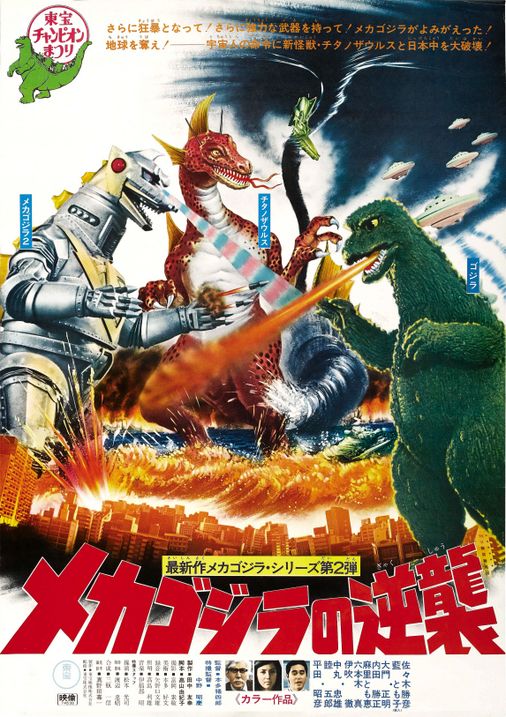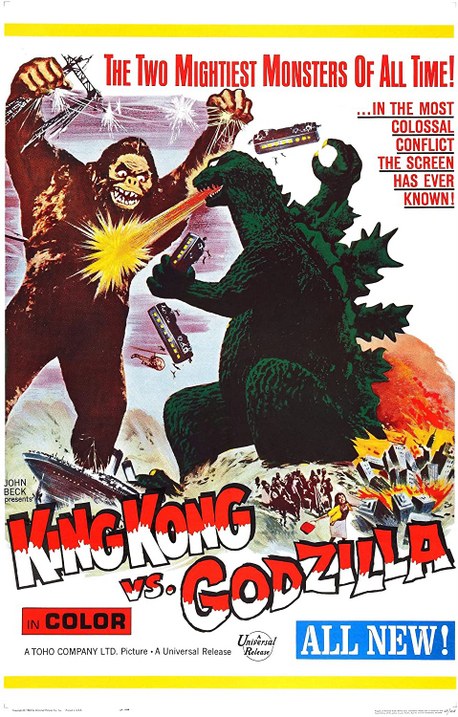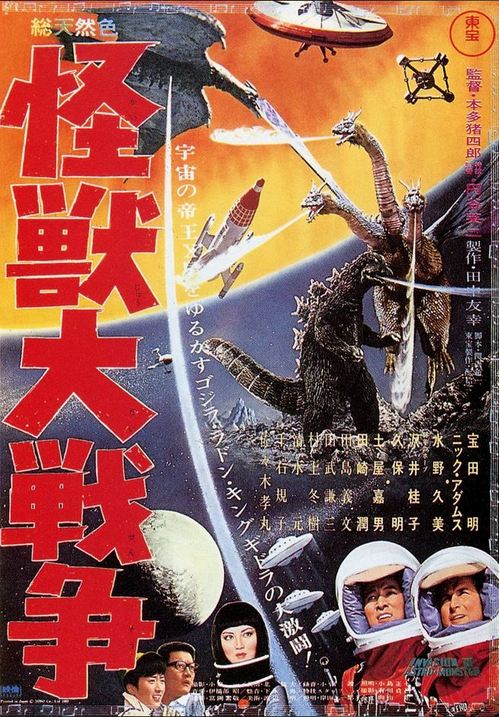Godzilla Ranking: The Showa Era (1954-1975)
It’s been a bumpy road for major releases, but Legendary Pictures’ MonsterVerse has a battle for the ages coming this Spring with Godzilla vs. Kong. After delivering my rankings for the Heisei Era and the Millennium Era, along with some fun facts and a beginner’s guide to the famed kaiju series, I took a bit of a break from huge Godzilla posts. However, it’s finally time to explore my ranking of the original period of Toho’s Godzilla films, the Showa Era, which ran from the 50s into the 70s, featuring a hefty 15 films. So, get ready for my ranking, fun trivia, and more.
–
As noted in the other ranking posts, there are distinct periods for the Godzilla franchise, reflecting the times studio Toho chose to reboot the series. Compared to the Heisei Era, which placed all of the films on a single timeline, and the Millennium Era, which served as an anthology series, the Showa films are more all-encompassing. One could see these films as connected, but they skip around in time and feature several other Toho-produced films not featuring Godzilla (only to have some of the monsters eventually make their way into Godzilla films).
Consisting of 15 films, while opening with a classic entry that emphasized the terror of Godzilla and the atomic age metaphor he stood for, the series quickly evolved after. More monsters were added, allowing for large-scale fights to become the centerpiece for the films. Godzilla evolved from being a villain to something closer to an anti-hero who fought off more threatening monsters. The series even went out of its way to emphasize its choice to appeal directly to children, thanks to a couple of entries focused on Godzilla’s son, the infamous Minya.
From a production standpoint, the first film’s ingenuity was replicated to a point, as monster designs were unique for the time, and elaborate sets and miniatures were produced to help deliver on some creative narratives. However, over time the budgets decreased, footage started to be reused, and there are arguments to be made for which directors knew how to deliver solid efforts with what they had available to them at the time. One thing is for sure, if you’re looking for a series devoted to guys in big rubber suits (suitmation) getting down and dirty in wrestling-type brawls, this is a packed era for that.
With all of that out of the way, let’s get to ranking these films and showing off more posters:
15. Ebirah, Horror of the Deep (1966)
AKA: Godzilla Versus the Sea Monster
The Setup: Teenagers on a sea cruise steal a boat and get caught in a storm, leading to a crash landing on a tropical island home to the terrorist organization Red Bamboo. Red Bamboo has enslaved the natives of the island, forcing them to process a juice that holds off the crab-like monster, Ebirah. Only with help from a native girl, Daiyo, can the innocent group wake up a slumbering Godzilla to defeat Ebirah, allowing them to escape the island.
Who Does Godzilla Fight: It’s a packed film, as Big G has to go up against Ebirah, a giant condor, and a squadron of Red Bamboo fighter jets. Even Mothra goes after Godzilla, as this film was still settled in a period where Godzilla was not quite the villain, but not quite the hero, either.
Thoughts: The first of the island films, a popular (cheaper) setting for future Godzilla movies, having this ranked lowest may cause some controversy given two of the more usual picks for the least liked of this era. However, as much as I enjoy crab as a meal, Ebirah just doesn’t do much for me. This is director Jun Fukuda’s first foray into Godzilla Land (taking over for Ishiro Honda), and he’s only able to deliver so much. There’s not a ton of Godzilla in the film (a common theme, but even this one is pretty minimal), and while the human stuff sounds fun on paper, it doesn’t deliver the fun compared to some of the other grounded adventures in this series. Really, it’s just a bit too much of a bore for me.
Bonus Trivia: Originally, King Kong was going to be the star of this film. One can tell based on the use of electricity powers previously exhibited by Kong in his movie with Godzilla, along with the “attraction” Godzilla has to Daiyo, another very Kong-like trait. It also explains why Godzilla and Mothra would fight, despite their previous team-up.
14. All Monsters Attack (1969)
AKA: Godzilla’s Revenge
The Setup: A bullied schoolboy, Ichiro, has dreams of traveling to Monster Island, where he befriends a similarly picked-on Minya, who eventually learns to stand up for himself, dealing with the monster Gabara in the process.
Who Does Godzilla Fight: This can be tricky due to the heavy use of stock footage (and we’ll get to those characters later), but to be clear, Godzilla (and Minya) only really fight Gabara, a kaiju that looks like Godzilla’s red-headed step-cousin.
Thoughts: Look, at a spot this low on the list, it’s not like I need to put up a heavy defense here (though you can hear my thoughts to a great degree on this Cult Cinema Cavalcade episode). Despite its aggressive “Revenge” title for the U.S. release, this is as kid-friendly as it gets (you might as well have Gamera narrate). Reportedly director Ishiro Honda’s favorite in the series, though I have my doubts on that, this cheaply made entry clocking in just over an hour does have a redeemable story element in the form of addressing bullying. There’s also a goofy charm to this clip show that makes it silly, even unnecessary, but somewhat enjoyable.
Bonus Trivia: Despite the increasing decisions to have Godzilla films appeal to a younger audience, this is the first Godzilla film to feature a child protagonist. All Monsters Attack is quite similar to Gamera: Super Monster for this reason, given how both films feature a large amount of stock footage and are both heavily looked down upon by fans of each respective series.
13. Godzilla Raids Again (1955)
AKA: Gigantis the Fire Monster
The Setup: Two pilots are shocked to learn a new Godzilla has emerged and is currently waging war against a new monster, Anguirus. These monster battles eventually lead to a fierce fight in Osaka, causing even more mayhem.
Who Does Godzilla Fight: Godzilla’s oldest enemy/occasional teammate, the dinosaur-like, horned creature Anguirus makes his debut here.
Thoughts: Even when taking away the proximity this film had to the original classic, Godzilla Raids Again still feels like a poorer version of both the original and the movies to come. Yes, it introduced the idea of Godzilla fighting other kaiju, but there’s nothing exceptional about this entry in terms of execution. There’s lesser direction, a lack of effort to get much drama out of this particular storyline, and the battles, as interestingly portrayed as they are (I’ll get to why next), leave little impact in the grand scheme of things.
Bonus Trivia: To effectively simulate the impact of a giant monster on land, the cameras filmed Godzilla scenes in slow motion. However, in this film, one of the three cameras used to film these scenes was set to record at the opposite speed, making the action appear fast than reality. Director Motoyoshi Oda liked what he saw and decided to use it anyway, making the fights stand out from the other movies. Also – this is George Takei’s first film.
12. Son of Godzilla (1967)
AKA: Frankenstein’s Monsters Hunt Godzilla’s Son (German)
The Setup: Scientists experimenting with weather changes on a tropical island (see what I mean, lots of island movies) get more than they bargained for when Godzilla shows up to battle giant insects while raising and protecting his newborn son.
Who Does Godzilla Fight: It’s bug city up in this film, as Godzilla faces off against a few Kamacuras, giant praying mantis-like monsters, and Kumonga, a giant spider. Big G must also fight off the frustrations of dealing with his newborn child, Minya (Minilla is also an accepted name).
Thoughts: I’ve never been too down on this film, given what it’s going for. Yes, it’s childish by design, as we are watching Godzilla as a daddy. That said, the human plot is better constructed than one may expect and even plays as a mild parody. Director Jun Fukuda seems more at home in his second attempt at a Godzilla film too. The special effects are better handled, the monsters feel more creative, and if you can get over how ugly a design Minya is, there’s fun to be had with his attempts to learn the King of the Monsters’ ways.
Bonus Trivia: In 2020, a species of Scytodes spider was discovered in Iran and named Scytodes Kumonga, after the giant spider in this film. Like Son of Godzilla’s Kumonga, Scytodes kumonga also has the ability to spray silk from its fangs.
11. Godzilla vs. Gigan (1972)
AKA: Godzilla on Monster Island
The Setup: Alien cockroaches from the dying planet M Space Hunter Nebula plot to conquer the world using Gigan and King Ghidrah, which they control from their secret headquarters inside the head of the Godzilla-replica at a theme park. The only thing that can stop them is the combined efforts of Godzilla and Anguirus.
Who Does Godzilla Fight: Despite the presence of stock footage, let alone former enemy Anguirus, Godzilla is once again taking on his old foe King Ghidorah, and the newcomer, Gigan, a cyborg kaiju with sharp hooked arms, a spikey tail and back spines, and a circular saw weapon in its chest.
Thoughts: This film has a couple of things going for it, despite my lower ranking. For one – Gigan is an impressive kaiju design and a deadly one at that. Godzilla almost loses due to the bloody battle he gets in during his tag team match, featuring Anguirus and King Ghidorah. There’s also the use of the Godzilla theme park and cockroach aliens, which is just inherently fun. That said, it’s a slower-paced film than it should be, with a lot of stock footage. But hey, at least we get to see Godzilla and Aguirus speak to each other.
Bonus Trivia: This is the first film to feature Godzilla visibly bleeding. While special effects director Eiji Tsuburaya had been opposed to having the monsters bleed, following his death, Teruyoshi Nakano took over the SFX department and chose to incorporate more monster bloodshed. Children actually asked why the monsters didn’t bleed, which made this a bit of a welcome change.
10. Godzilla vs. Megalon (1973)
AKA: Gogo and Superman Meet in Tokyo (Spain)
The Setup: The undersea nation of Seatopia sends the Megalon, a gigantic beetle, and Gigan to destroy the world above. It’s up to Godzilla and a size-shifting robot, Jet Jaguar, to defeat him.
Who Does Godzilla Fight: Despite the appearance of Rodan and Anguirus, Monster Island is destroyed (oh no!), leaving Godzilla without his friends. However, despite a long break, he eventually joins the fight with Jet Jaguar to take on Megalon and Gigan in one of his most wrestler move-friendly battles.
Thoughts: However much one may like this film, it’s undoubtedly a popular entry for a couple of reasons. There’s the famous flying kick Godzilla delivers (twice), as well as Jet Jaguar, the bizarre Ultraman knockoff that allows the humans to have something fun to work off (Being a popular MST3K episode doesn’t hurt either). Really, I just see this as a few notches ahead of Gigan due to better pacing, more outrageous ideas, and director Jun Fukuda seemingly delivering some of his best work despite such limited means.
Bonus Trivia: Many fans saw this as the weakest of the Showa Era, as it became the only Godzilla film to be shown on American network television in 1977. It was presented on the NBC network in an edited version hosted by John Belushi dressed in a Godzilla costume. This was seen as a reason many never took the series seriously, as it seemed to pass as cheap children’s entertainment.
9. Godzilla vs. Mechagodzilla (1974)
AKA: Godzilla vs. The Cosmic Monster
The Setup: Ape-like aliens intend to take over the planet, and they have built a mechanical version of Godzilla to stop the real Godzilla from interfering. The Earth humans summon the legendary lion-god creature, King Caesar, to assist Godzilla in the battle.
Who Does Godzilla Fight: A Godzilla fights Anguirus and nearly kills him, but it’s actually the imposter, as the real Godzilla arrives and spends plenty of time fighting this Mechagodzilla with help from King Caesar.
Thoughts: This film is a lot of fun. As Fukuda’s final effort, it really delivers on the spectacle of this series. The fights are very enjoyable, the designs are superb, and just the concept of Mechagodzilla never gets old to me. There’s even a good amount of effort put into the story, ridiculous as it is. This film remains one of the more popular of the series for a good reason.
Bonus Trivia: When Universal Studios, responsible for both The Six Million Dollar Man and The Bionic Woman, threatened to sue Cinema Shares Releasing over the U.S. title, “Godzilla Vs. the Bionic Monster,” the movie was quickly re-titled Godzilla vs. the Cosmic Monster. Meanwhile, Germany decided to refer to Mechagodzilla as King Kong, most likely due to Kong’s popularity. Germany did the same thing with Jet Jaguar (Germans do not know what apes look like, I guess).
8. Mothra vs. Godzilla (1964)
AKA: Godzilla vs. The Thing
The Setup: A typhoon washes ashore a gigantic egg that’s claimed by greedy entrepreneurs near Nagoya. They refuse to return it to its rightful owner, Mothra. In the meantime, Godzilla washes ashore from the same typhoon and begins a rampage, with Japan now hoping Mothra can save the day.
Who Does Godzilla Fight: In addition to the military forces try to stop him, this is Godzilla’s first big battle with Mothra in her adult form, as well as in her larvae form, as two hatch from an egg and take on Big G.
Thoughts: I think I’m just more interested in Mothra as a supporting player, as opposed to the main event. That said, this film does offer a pretty great throwdown between the two, with the unique nature of Mothra (being on that flies) allowing for a change-up in the way the two clash. As far as what’s going on around these two, I find enough to enjoy in how this film brings Mothra over from her own movie to create Toho’s cinematic universe. The Shobijin twins are a fun element to add to the ridiculousness, and Ishiro Honda is still having plenty of fun as director.
Bonus Trivia: Generally, the special effects crews work on miniatures to deal with the monsters’ scale. This film marked one of the few instances in which Eiji Tsuburaya had to work at the opposite scale to create giant furniture props for the twin Shobijin fairies to inhabit.
7. Terror of Mechagodzilla (1975)
AKA: The Terror of Godzilla
The Setup: Godzilla comes to the rescue when an alien race (aliens of the Third Planet from the Black Hole) rebuilds Mechagodzilla to destroy Earth’s cities. To help the aliens, a traitorous scientist provides a second weapon: Titanosaurus.
Who Does Godzilla Fight: A rebuilt Mechagodzilla and the aquatic dinosaur Titanosaurus take on Godzilla in this final entry of the Showa Era.
Thoughts: While not exactly surprising, it’s a shame this film did poorly at the time of its release. Following more kid-friendly entries, director Ishiro Honda and original composer Akira Ifukube returned to deliver a darker, more interesting entry that recalled some of the series’ earlier days. That doesn’t mean the film is less fun, but the film attempted to strike a specific tone that featured more interesting characters and some pretty great fights. Godzilla may have laid dormant for a decade following this film, but this entry did well to close out the era.
Bonus Trivia: Despite being a fan favorite, this film is one of only two live-action Godzilla movies to have sold less than one million tickets in Japan, making it one of the least attended films of the original series (Despite the presence of Jet Jaguar, Godzilla vs. Megalon was the other).
6. King Kong vs. Godzilla (1962)
AKA: The Triumph of King Kong (Italy)
The Setup: A newspaper and television station funded by a pharmaceutical company wants a sensation, which happens to be the discovery of King Kong on an island. He is captured and brought to Japan, where he escapes from captivity and battles Godzilla.
Who Does Godzilla Fight: There’s only one big battle for Big G this time, and it’s with King Kong. However, Kong gets a chance to fight a giant octopus before the main event.
Thoughts: This one has grown on me over the years, mainly because the Criterion release brought with it the original Japanese version of the film, which restores many of the elements that made this film as much as comedic satire as it was a kaiju film. While the American version strips things down to the bare minimum, Ishiro Honda’s vision was to acknowledge how ludicrous this premise was and have a different kind of fun with it. It doesn’t entirely make up for how silly this version of King Kong looks, but it’s a more intelligent film than it gets credit for being.
Bonus Trivia: There’s a popular myth that two endings exist for this film, with the American version ending with Kong’s victory, while Godzilla is declared winner in the Japanese version. This came about due to an article in Spacemen magazine, which printed this story, only to have it reprinted in various issues of Famous Monsters of Filmland in years that followed. The myth has since been dispelled.
5. Godzilla vs. Hedorah (1971)
AKA: Godzilla vs. The Smog Monster
The Setup: Coming to Earth on a fallen meteorite, the alien life-form, Hedorah, feeds on Earth’s pollution and grows into a gigantic, ever-evolving, poisonous gas and acid-secreting monster, Hedorah, the smog monster, destroys Japan and fights Godzilla while spewing his toxic gas to further the damage.
Who Does Godzilla Fight: There’s no room or need for anything else but Hedorah in this entry.
Thoughts: This movie is a blast for all the things it dares to do differently. Godzilla vs. Hedorah is a strange beast that dabbles in the surreal and the weird thanks to the effort put in by director Yoshimitsu Banno. The inventive and gross monster design allows for some really nasty fights with Godzilla. The battles being staged at night allowed for a different look compared to the other films (also, Godzilla uses his atomic breath to fly at one point, which is incredible). Plus, there’s the environmental messaging to even provide some depth to this outrageous feature.
Bonus Trivia: Director Banno was incredibly pleased with his film, but producer Tomoyuki Tanaka disliked this film so much he banned Banno from directing another Toho feature. That said, Banno would persist years later in an attempt to make a 40-minute IMAX 3D Godzilla film. It never came to be, but he successfully helped build the bridge back with America to develop 2014’s Godzilla and Legendary’s MonsterVerse before his death in 2017.
4. Ghidorah, The Three-Headed Monster (1964)
AKA: Ghidrah The Tricephalic Monster (Brazil)
The Setup: The disappearance of a princess coincides with the arrival of a prophetess from Venus. She warns of Godzilla’s return, Rodan’s return, and the arrival of a civilization-destroying space monster known as King Ghidorah. It will be up to Mothra to unite Godzilla and Rodan to take on this three-headed dragon of doom.
Who Does Godzilla Fight: Godzilla and Rodan aren’t exactly friends, and they deal their damage to each other, but the primary opponent is King Ghidorah in his first appearance in the series.
Thoughts: Plenty of fun to be had here, as this film features four of the most famous kaiju in a major series entry, directed by Honda, and scored by Ifukube. The human story works as well as it needs to, introducing aliens for the first time and making for an enjoyable diversion when not focused on the monster brawl and all the build-up to it. Only so much to add because this is just pure Showa Era entertainment.
Bonus Trivia: This is the first film to portray Godzilla as a hero. Also, in the conversation with Mothra, he states that he only hates humans because they attacked him with their weapons and military, suggesting Godzilla was not really a villain in the first place (yeah, they wanted these films to be more kid-friendly).
3. Invasion of Astro-Monster (1965)
AKA: Godzilla vs. Monster Zero
The Setup: Aliens known as the Xiliens arrive on Earth seeking to borrow Godzilla and Rodan to save their planet from something known as Monster Zero. Also sent on the expedition are astronauts Glenn and Fuji, who discover Monster Zero is none other than King Ghidorah, and the Xiliens have more plans for Earth than they have let on.
Who Does Godzilla Fight: Taking the fight to space, Godzilla and Rodan are teamed up again to go after King Ghidorah.
Thoughts: Much like the previous entry that introduced King Ghidorah, this is another Godzilla movie with everything going for it. The monster fights are fun, the special effects are at their finest for the time, and the human story is delightful thanks to a reasonable amount of chemistry between Nick Adams and Akira Takarada (even when dubbed, there’s a lot of funny interactions between them). The Xiliens make for a solid alien enemy as well. Everything just clicks into place on this film, making
Bonus Trivia: Following the first battle with King Ghidorah, Godzilla performs a victory dance that resembles a famous pose from a popular Manga, “Osomatsu-Kun.” This was essentially snuck in by effects director Eiji Tsuburaya and liked so much by him and others that Godzilla performed it multiple times in the sequence. However, director Ishiro Honda was not amused and reportedly furious at this lighter element incorporated into the film.
Another fun fact – Invasion of Astro Monster was released in America on a double bill with War of the Gargantuas, another kaiju classic from Ishiro Honda, making it one of the best double-features I’ve ever heard about.
2. Destroy All Monsters (1968)
AKA: The Monsters are Threatening the World (Finland)
The Setup: Aliens have released all the giant monsters from their imprisonment on Monster Land and are using them to destroy all major cities on the planet. It is up to the intrepid crew of the super rocket ship X-2 to infiltrate the aliens’ headquarters and un-brainwash these monsters before the Earth monsters, and King Ghidorah annihilate the planet.
Who Does Godzilla Fight: To be technical, Godzilla fights New York City and King Ghidorah. However, this is a monster mash for the ages, as the film also features Rodan, Anguirus, Gorosaurus, Mothra, Minya, Manda, Kumonga, Baragon, Varan, and, of course, King Ghidorah.
Thoughts: This movie rules! Yes, it is primarily because of the large assortment of kaiju pulled in for this mega mash of monster battles, serving as a kaiju movie cereal that’s all marshmallows, but who cares when it’s this much fun? What the film trades in its story (it’s a little thing), it makes up for in being for kaiju films what the Avengers was for superhero movies. Plus, it’s well made. Akira Ifukube’s wonderfully booming soundtrack does a lot of good for this movie, and Ishiro Honda returned in top form after stepping away for a few films.
Bonus Trivia: Destroy All Monsters was originally intended to be the last Godzilla movie. It was even set in the future (1999!), whereas the other films are set in the year they were made. However, the film was such a substantial success that Toho decided to continue producing more films. With that in mind, the proceeding film was Honda’s All Monsters Attack, which was composed of a lot of stock footage and didn’t exactly resonate well with fans.
1. Godzilla (1954)
AKA: Godzilla, King of the Monsters!
The Setup: American nuclear weapons testing results in creating a seemingly unstoppable, dinosaur-like beast, which heads towards Japan, causing destruction in Tokyo and other cities, while an overwhelmed military attempt to stop it.
Who Does Godzilla Fight: Japan.
Thoughts: Sure, there may be a sense of giddiness that comes with some of the other films to provide for a genuinely wonderful viewing experience, but it is this darker, serious, first entry that remains the best of the Showa Era, let alone the franchise (though Shin Godzilla is pretty dang close to topping it). Being an ambitious film for its time, it’s not just that it featured an iconic monster that would influence films for years to come, but that it had more than just B-movie thrills on its mind. It’s an important film in history thanks to its use of genre to comment on the genuine fears of the time regarding the atomic age and nuclear holocaust, and Japan’s position in the world following WWII. On top of that, yes, the filmmakers involved did something unlike many others spawning the longest-running film franchise in history. With all of that, there’s a film I have enjoyed for decades.
Bonus Trivia: At the time of its release, Godzilla was the most expensive Japanese film ever made. The combined production of both this film and Seven Samurai (made by Ishiro Honda’s good friend Akira Kurosawa) in 1954 almost plunged Toho into bankruptcy. However, both films ended up being sizable box office hits, which let the studio continue to produce plenty more kaiju films.
***
And there you have it! I have now ranked the Showa Era, completing my ranking series of all the franchise eras. In addition to the American MonsterVerse films from Legendary, we are currently in the Reiwa era as far as Toho is concerned, though it currently only consists of the terrific Shin Godzilla and the three anime Godzilla films, which can be found streaming on Netflix (and the anime series Godzilla: Singular Point is coming soon). As far as how all of these films stack up, I have a complete ranking of the entire series available on Letterboxd. I hope you’ve all enjoyed this long look at one wild time in the realm of monster movies.






